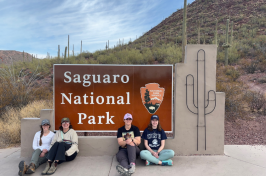
Lynette Davis, a graduate student pursuing dual degrees in computer science and ocean mapping, is back at sea again. In the middle of changing her artistic career path from jewelry making and metalsmithing, Davis used the resources offered at UNH to pursue a different lifestyle and vocation.
Thanks to a grant from the National Oceanographic and Atmospheric Administration (NOAA), Davis is tackling automated data quality control for multibeam data; multibeam sonors are used to map the seabed. The ocean covers more than 70 percent of the Earth, yet more than 85 percent of the ocean floor is still unexplored.
While NOAA’s technology allows for a more automatic system, Davis says a person must still manually sift through the data. This pipeline process of collected data being translated into a usable chart for mariners is not quick.
“It takes about two years,” Davis says. This is the assignment she will be working on throughout October, on top of remotely continuing her regular graduate coursework.
While NOAA’s technology allows for a more automatic system, Davis says a person must still manually sift through the data.
During the summer of 2018, Davis and the team at the Autonomous Surface Vehicles (ASV) lab traveled to American Samoa aboard the Nautilus where many areas of the ocean floor are still unmapped. On that trip, the team collected at least 7,000 records per second.
“It was really amazing,” she says. “I totally didn’t want to leave.”
After finishing her undergraduate study at the University of Wisconsin-Madison in 2010 with a BFA in art, Davis’ previous experience working on ships as a deckhand inspired her to pursue graduate studies in the STEM field. In 2017, when she enrolled in the graduate program, UNH was one of only two universities to offer an ocean mapping program.
“I stumbled upon this article about seafloor mapping and what people were doing to map the seafloor,” Davis says. “I was interested in autonomous vehicles and mapping the seafloor using robots.” She decided combing computer science and ocean floor mapping gave her the best opportunities.
“If there is a problem to be solved, put me on it and I’ll see if I can figure it out,” Davis says, adding that her excitement comes from her passion for working in the ocean, curiosity to solve problems and collective support from the graduate study department.
-
Written By:
Meghan Murphy '20 | Communications and Public Affairs

















































